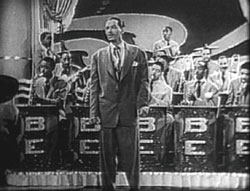 The original short short feature film Rhythm in a Riff (1945) of about a half-hour, was distributed in its entirety by Astor Films & the Associated Producers of Negro Motion Pictures. The original short short feature film Rhythm in a Riff (1945) of about a half-hour, was distributed in its entirety by Astor Films & the Associated Producers of Negro Motion Pictures.
The actual producer was William Alexander, whno to maximize profits broke it down into three-minute soundies the following year, to be distributed to Panoram visual jukeboxes. Alexander had qutie a career & was even the official filmmaker for Hale Salasie in Ethiopia.
In the full version, Billy Eckstine plays Billy Martin, whose band is rebelling against him for lack of paying gigs. He scores an improtant audition with Joe Corwin (Emmett "Babe" Wallace) who is opening a new club & needs a premier act.
Corwin's constant companion Helen (Sarah Harris) shares Corwin's immediate fondness for the band, on the basis of just the title song "Rhythm in a Riff." When Billy Martin falls in love with Helen, it looks like a bad thing that could get in the way of the band's success. Fortunately, as eventually revealed, Helen & Joe are not to be romantically involved at all; they're merely great friends.
The bulk of the rest of the film consists of the musical performances done for the opening night in Joe's new club.
When the film was stripped down to just the music for distribution to Panoram visual jukeboxes, the story of the feature film vanished & there is no longer anyone named "Billy Martin" but just the music of Billy Eckstine. Yet a few cuts-to-audience include acting scenes for Babe Wallace & Sarah Harris that may strike some as a mite odd for soundies.
A dozen numbers are packed into the short feature, inclusive of a generic boogie woogie performance behind some dialogue & chorus dancers. Only six of these numbers were distributed separately as soundies. The story never mattered much anyway, but there is more music in the short feature if there's ever a chance to see it in its entirety.
The numbers not available as soundies include "Second Balcony Jump," written by Billy & Gerry Valentine. We first hear a fragment of it behind the short feature's opening credits. Halfway through the film we get the whole number. Billy sings it together with a line of chorus girls. There are highlighting moments not only for Billy on his valve trumbone (a trumbone that requries no slide component), but also for Gene Ammons on tenor sax.
Also missed if all one sees is the six excerpted soundies is the jump-jazz instrumental "Taps Miller" written by Buck Clayton, one of the great jazz trumpeters & band arrangers. Here the trumpet solo is by Hobart Dotson, plus tenor sax solo Frank Wess.
"Taps Miller" was followed by another tune not excerpted as a soundie, "Our Delight" written & arranged by Tad Dameron, backing up a dance sequence for Al Guster & Nicky O'Daniel. Billy has a valve trumbone solo, Frank Wess a tenor sax solo, & Hobart Dotson a trumpet solo.
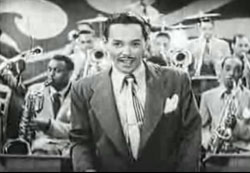 The three-minute soundie version of Rhythm in a Riff (1946). The song's full title is "I Love the Rhythm of the Riff." It gives Art Blakey a lovely moment on the drums, & a superb tenor sax solo for Gene Ammons. The three-minute soundie version of Rhythm in a Riff (1946). The song's full title is "I Love the Rhythm of the Riff." It gives Art Blakey a lovely moment on the drums, & a superb tenor sax solo for Gene Ammons.
Although composed as jump-jazz, with some built-in "de-lo-do" scat, the lyrics are sung by Billy in a style more in keeping with commercial swing tunes of the era. Billy was a crooner foremost even when he sung a fast upbeat piece of jazz:
"Jump jump your rhythm with a riff/ Any kind of music gets a lift/ Bo do lodo oh do lodi-o-do anything to make it swing."
Billy's just gosh darned handsome (pretty really), standing there with his own orchestra behind him. The camera shows a few longshots so we can see he's singing in a club setting. We see customers seated, showgirls standing around swaying to the tune. There's Ammons' great jazz sax solo at the midway point, then back to Billy for a scat conclusion.
The man & woman in the audience are assessing Billy's merits & don't find him wanting. They're Babe Wallace & Ann Harris who may seem slightly out of place in a soundie. They're later seen again in the audience for the excerpted soundie Prisoner of Love (1946) in different outfits, & the club setting is different as well for the rest of the soundies. This is because Rhythm in a Riff had been (in the short-feature version) performed as an audition before the new club was ready to open.
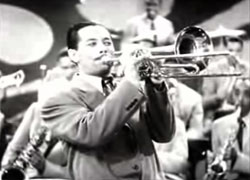 The remaining soundies all have a common setting. You Call it Madness (1946) is a tune written by Con Conrad, Russ Columbo, Gladys Du Bois & Paul Gregory, which runs in part: In the short-feature we hear a bit more of it in a scene wherein Billy sings a-capella. The lyrics, sung in a lilting smooth & intensely romantic baratone, run in part:
The remaining soundies all have a common setting. You Call it Madness (1946) is a tune written by Con Conrad, Russ Columbo, Gladys Du Bois & Paul Gregory, which runs in part: In the short-feature we hear a bit more of it in a scene wherein Billy sings a-capella. The lyrics, sung in a lilting smooth & intensely romantic baratone, run in part:
"I can't forget the night I met you, that's all I'm dreaming of/ And now you call it madness, but I call it love/ You made me promise to be faithful by all the stars above/ Now you call it madness, but I call it love."
For a change, the Eckstine-Valentine composition Lonesome Lover Blues (1946) has Billy belting one out rather than crooning, & at the top of his vocal range. So it's closer to a jump-blues vocal than one usually expects of him, even when the band arrangements are overtly jump & in a couple years he'd be backed up by be-bop arrangements. It could even be considered bluesy roots-rock, which can be said of very little of Mr. B's songs:
"I walk round in circles, don't know just where to go/ I walk round in circles, don't know just where to go/ I wonder why did she leave me, how could she hurt me so..."
At the instrumental break, Frank Wess wales on the tenor sax. There's a jump-cut to a couple in the club audience really digging the sax. Billy has a valve-trumbone solo. Then Billy solos on his valve-trumbone before a bank of saxophones brings it to a close.
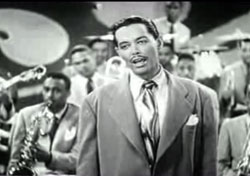 Prisoner of Love (1946) is a written by Leo Robin, Russ Columbo, & Clarence Gaskill composition. Prisoner of Love (1946) is a written by Leo Robin, Russ Columbo, & Clarence Gaskill composition.
This is another silkly-smooth vocal performance as Billy croons sexily: "Although from night to night you'll find me/ too weak to break the chains that bind me/ I need no shackles to remind me/ I'm just a prisoner of love."
In his Sunday best & swaying from side to side, Billy really was one of the biggest sex symbols of the '40s. Ahead of Nat "King" Cole, Billy was the first really big cross-over artists beloved by white as well as black audiences as "Mr. B," & his universal appeal is evident in these songs.
"These songs" were primarily love songs, in days of segregation when the very notion of a black artist singing love songs that white women adored was radical. In the 1950s this would force Billy into the Civil Rights arena. He once said, "It sounds ridiculous but it's true. We weren't supposed to sing about love, we were supposed to sing about work or blues."
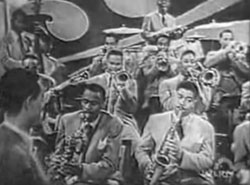 Billy wrote a veritable swing standard in I Want to Talk About You (1946), covered by many great artists, few so well as Billy himself, with his mellow prestine baritone. He's again crooning in a swing style, romantically handsome & smoothly mainstream rather than jive: Billy wrote a veritable swing standard in I Want to Talk About You (1946), covered by many great artists, few so well as Billy himself, with his mellow prestine baritone. He's again crooning in a swing style, romantically handsome & smoothly mainstream rather than jive:
"Don't tell me about a night in June/ Or a shady lane beneath the velvet moon/ Don't tell me, 'cause I want to talk about you..."
The tight, slimmed down arrangement is strictly for the vocal, & there are no instrumental soloists this time. As in the other soundies in this series, the Billy Eckstine Orchestra is portrayed as the floor show of a nite club. The two jump-cuts to the audience show Babe Wallace & Sarah Harris.
Billy didn't begin to put his orchestra together until late in 1943, & by 1947 he disbanded the orchestra to become a solo act, his career continuing on an upard curve for some years after. So these soundies are a rare opportunity to actually see the Billy Eckstine Orchestra at its peak.
Billy turns over singing duties to Ann Baker for I Cried for You (1946), but giving himself a valve trumbone solo. The song was written by Arthur Freed, Gus Arnheim, & Abe Lyman.
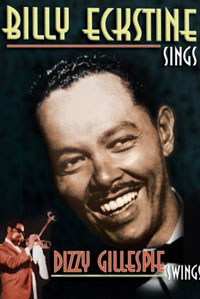 Billy's soundies were further recycled into new combinations. Billy Eckstine Sings (1947) was an Official Films home-movie omnibus consisting of I Want to Talk About You,Lonesome Lover Blues & Rhythm in a Riff. Billy's soundies were further recycled into new combinations. Billy Eckstine Sings (1947) was an Official Films home-movie omnibus consisting of I Want to Talk About You,Lonesome Lover Blues & Rhythm in a Riff.
Unseen is another film release, a one-reeler called Harlem After Midnight (1949) which included I Cried for You with Ann Baker's vocal, Billy singing I Wanna Talk About You & one of the initial short-feature's numbers excluded from the soundies set, "Our Delight" with dancers Al Guster & Nicky O'Daniel.
Another lost edit was called Flicker Up (1946) & is cited in filmographies as co-starring Billy Eckstine & Marylou Harris, an evident error for Sarah Harris from the short-feature cast, who did not sing in that film.
What songs may have been in Flicker Up I couldn't discover, though if Harris was a mistake for Ann Baker, then I Cried for You must've been included. It was conceivably a distinct featurette rather than recycled numbers.
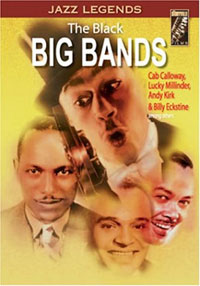 Blue Harlem (1946) may well be a phantom film rather than just lost, cited only by Klaus Stratemann in Negro Bands on Film (1981) as another short-subject arrangement of three numbers from the 1945 short-feature, though if Billy really sang the popular song "Blue Harlem" it would've had to have been completely different. Blue Harlem (1946) may well be a phantom film rather than just lost, cited only by Klaus Stratemann in Negro Bands on Film (1981) as another short-subject arrangement of three numbers from the 1945 short-feature, though if Billy really sang the popular song "Blue Harlem" it would've had to have been completely different.
Likewise a lost film is Play It, Brother (1947) combines soundie material by Billy Eckstine with Lucky Millinder & His Orchestra, Lucky's portion almost certainly taken from Lucky Millinder (1946) distributed by Astor Films, produced by William Alexander & directed by Leonard Anderson. Lucky's numbers were likewise spun out as a series of soundies, namely I Want a Man, Hello Bill & Big Fat Mamas.
Later compilations of Mr. B right up to the present continue to present selections of the same material first filmed in 1945. Typical is The Golden Age of Classics of Jazz: The Best of the Big Bands (1980), eighty minutes of soundies, telescriptions, & clips including Eckstine's soundies Prisoner of Love & Rhythm in a Riff.
Clips from the 1945 short-feature are also available in the compilation dvd Swing Era: Billy Eckstine/Gene Ammons, Rhythim in a Riff (2000), together with soundies & telescriptions of the orchastras of Andy Kirk, John Kirby, Tix Beneke, Johnny Long, Ozzie Nelson, and Johnny Messner, and one odd-ball-out clip of Bing Crosby. Though Ammons' name gets put in the compilation's title, he has a sax solo only on "Second Balcony Jump" & "I Love the Rhythm in a Riff."
The same Eckstine selection can also be had on Billy Eckstine Sings & Dizzy Gillespie Swings (2004). Excerpted from the short feature are "(I Love the) Rhythm in a Riff ," "You Call it Madness (I Call it Love)," "Second Balcony Jump," "Lonesome Lover Blues," "Taps Miller," "I Want to Talk About You" & "Our Delight ," missing only "Prisoner of Love" & "I Cried for You" as on the Swing Era compilation, but this compilation drops the miscellaneous bands & gives instead an equal amount of Dizzy Gillespie.
Another compilation is The Black Big Bands (1999) featuring four bandleaders, Cab Calloway's Jitterbug Party (1935), Lucky Millinder excerpted from Boarding House Blues (1948), & Andy Kirk excerpted from Killer Diller (1948), besides all Billy Eckstine's numbers excerpted from the 1945 short-feature Rhythm in a Riff.
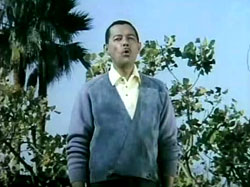 In a lipsynced performance of his Motown recording The Prime of My Life (1965) filmed in full color, Billy is initially shown standing outside in a garden.
In a lipsynced performance of his Motown recording The Prime of My Life (1965) filmed in full color, Billy is initially shown standing outside in a garden.
This was made for the Scopitone visual jukebox market which attempted to recover the 1940s Panoram fad updated for the 1960s, with moderate success in France & a much smaller success in America where at the time jukebox distribution to major cities was pretty much controlled by the mob which blocked rival product.
With the third line of lyrics, the scene jump-cuts to another part of the garden (which here looks like a golf course with tropical palms along the edge) with Billy leaning uncomfortably over a girl in a hammock. She barely ever smiles in this little film, & since Billy's quite a bit older than she is, there's a slight edge of creepiness in Billy's hovering behavior & the young woman's uninviting scowls.
The scene next cuts to Billy at pool-side with the girl on a bench, in increasingly uncomfortable looking poses. In one of the many jump-cuts to follow, you can see automobiles rushing on the road in the background.
The lyric runs in part: "The prime of my life has begun tonight/ The world is just one day old/ The rhyme of my life has a reason now/ My hand has love to hold."
There's so much echo added by Motown that Billy sounds a mite too much like Ed Ames as recorded around the same era. The song is rather bland but does sound like music heard in the 1960s when it avoided anything that sounded the least bit new.
Billy's smooth deep intonation was definitely old-fashioned by now, & neither was he the perfect fashion-plate for youth that he was in the late '40s & early '50s. Or to put in in a kinder frame, Eckstine was too "cultured" for the youth market, & had become, like other swing stars confronted with the rock & role era, less & less a successful recording star though still bringing in older crowds to concerts. Motown respected him as a past giant, however, & they permitted him quite a few '60s recordings that never hit the charts.
copyright © by Paghat the Ratgirl
|
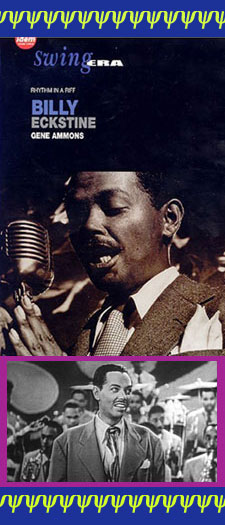






 Blue Harlem (1946) may well be a phantom film rather than just lost, cited only by Klaus Stratemann in Negro Bands on Film (1981) as another short-subject arrangement of three numbers from the 1945 short-feature, though if Billy really sang the popular song "Blue Harlem" it would've had to have been completely different.
Blue Harlem (1946) may well be a phantom film rather than just lost, cited only by Klaus Stratemann in Negro Bands on Film (1981) as another short-subject arrangement of three numbers from the 1945 short-feature, though if Billy really sang the popular song "Blue Harlem" it would've had to have been completely different.